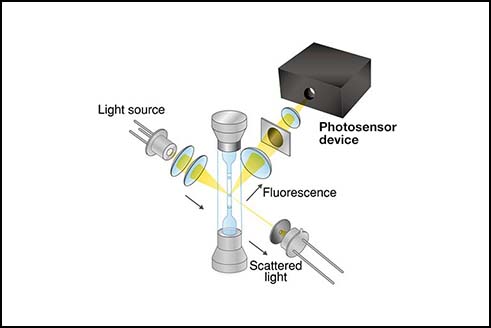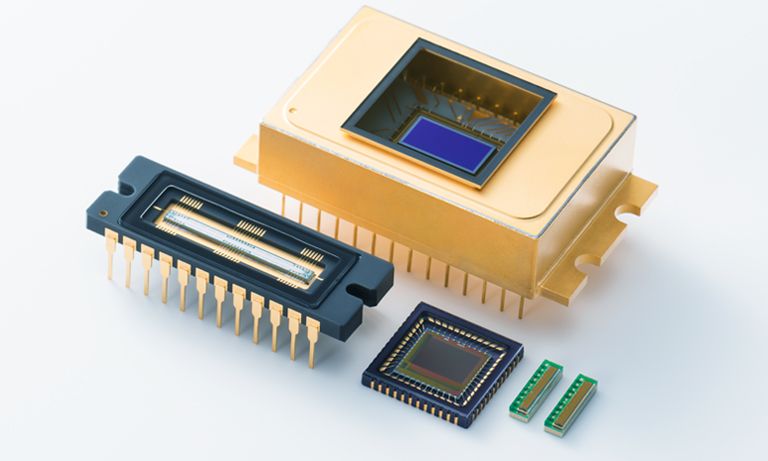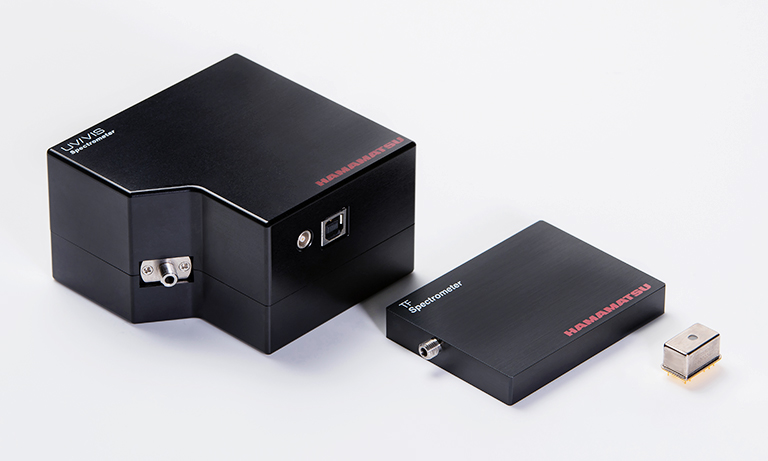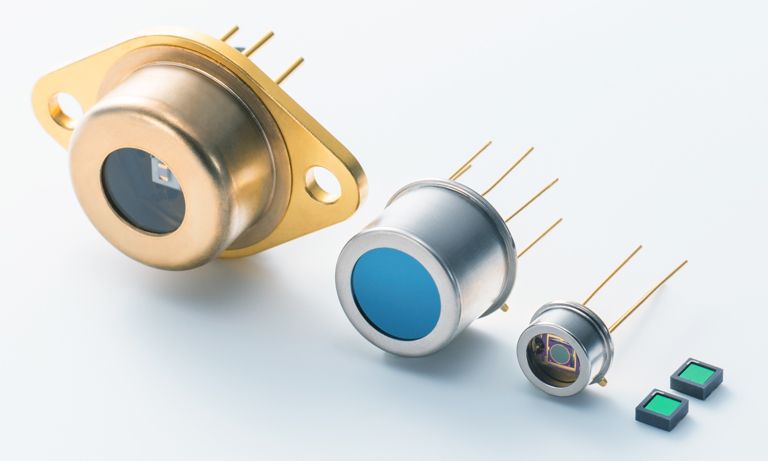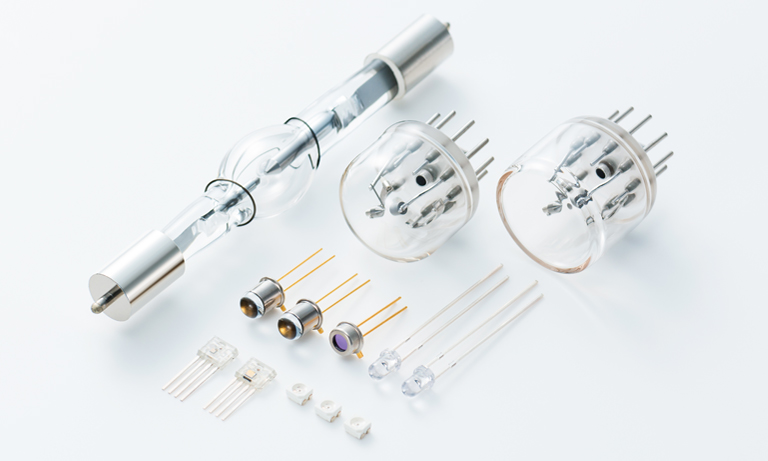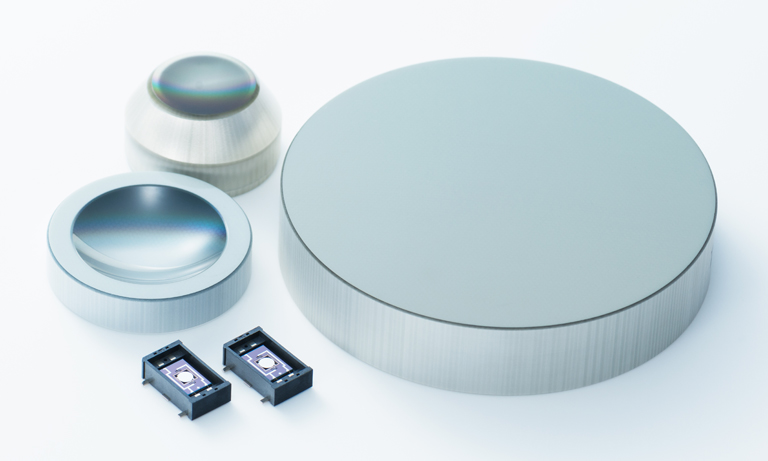Application notes
Technical notes
Ask an engineer
Publications
United States (EN)
Select your region or country.
How does temperature affect the gain of an SiPM?
Slawomir Piatek, PhD, Hamamatsu Corporation & New Jersey Institute of Technology
December 8, 2016
Introduction
A silicon photomultiplier (SiPM) is a solid-state photodetector capable of single-photon detection due to its high 105 − 107 internal gain (μ). Only one other photodetector, a photomultiplier tube (PMT), can achieve gain of such magnitude. Since its introduction in the mid-1990s, the SiPM has been undergoing a rapid development improving the performance. Compared to the first prototype, some undesirable characteristics such as high dark count rate density and high probability of optical crosstalk and of afterpulsing have been substantially reduced. These improvements, together with advantages over a PMT such as, to name a few, lower operating voltage, immunity to magnetic fields, and ruggedness, make a SiPM a viable alternative to a PMT as the detector for applications involving very low light levels. Many applications require stability of the photodetector's gain with respect to temperature changes. Fluctuating temperature can affect the gain of a PMT and SiPM; to prevent this, the photodetector operates either at a controlled constant temperature or at the ambient temperature but employing a gain-compensation circuitry. This technical note discusses the origin of the gain-temperature dependence in a SiPM and methods that the practitioner can use to correct for it.
Origin of the gain
A SiPM is a rectangular array of square microcells. Each microcell is composed of a series combination of an avalanche photodiode (APD) and a quenching resistor RQ. All of the microcells are in parallel; thus, a SiPM has two terminals: anode and cathode. All of the APDs and quenching resistors are identical. To achieve high gain, the reverse bias VBIAS applied to the SiPM exceeds the breakdown voltage VBD of the APDs by up to several volts. Thus, the APDs operate in Geiger mode: once initiated, an avalanche would have been perpetual if it hasn't been quenched by an external (to the APD) circuitry, for example, RQ. A SiPM is a current source: in response to a photon, the output is a current pulse i(t) and the gain equals the area under the pulse or . One can show that to an excellent approximation, μ is given by:
Equation 1
where ΔV is referred to as an "overvoltage," CJ is the capacitance of the APD's avalanche region and known as "junction capacitance," and e is the elementary charge. Equation 1 contains no explicit dependence on temperature, but there is an implicit dependence: it is well known that VBD is a function of temperature, VBD = VBD(T). Additionally, one may not rule out the possibility that CJ can also vary with T. If VBIAS is held constant, μ = μ(T) because ΔV = ΔV(T) and, possibly, CJ = CJ(T). The total derivative of μ with respect to T is given by:
Equation 2
Because there is no explicit dependence of μ on T, the first term on the right hand side of Equation 2 is zero. Using Equation 1 and assuming that VBIAS is independent of T, after some rearranging, Equation 2 becomes:
Equation 3
Both ΔV and CJ are positive; therefore, the overall sign and magnitude of dμ/dT depends on the sign and magnitude of each term in the parentheses. The next paragraph discusses the first term.
Otte et al. (2016) is the most recent study to investigate how the key opto-electronic characteristics of a SiPM depend on T. It finds that CJ has a statistically insignificant correlation with T, as indicated by Figure 1 below.

Figure 1. Dependence of junction capacitance on temperature for Hamamatsu S13360-3050CS SiPM. The figure is from Otte et al. (2016).
The best linear fit yields dCJ/dT = 0.015 ± 0.009 fF/°C. Taking CJ ≈ 111 fF from Figure 1, a one degree °C change in T causes a fractional change in CJ of about 0.014%. This change is small; thus, the first term in the parentheses of Equation 3 can be neglected, and CJ can be assumed constant in the second term. Therefore, the sign and magnitude of dμ/dT depends on how VBD varies with T, as discussed next.
Otte et al. (2016) uses three different methods to determine the relationship between VBD and T. All three methods indicate a linear dependence with nearly identical slopes as shown in Figure 2. The average slope, or dVBD/dT, is about 55.7 mV/°C implying, according to Equation 3, that μ decreases linearly with T. For ΔV = 3 V, the one-degree °C change in T causes ~1.9% fractional change in ΔV — this is significant. The temperature-induced change of ΔV affects not only the gain but also other characteristics of a SiPM such as photon detection efficiency, dark count rate, crosstalk, and afterpulsing probability.
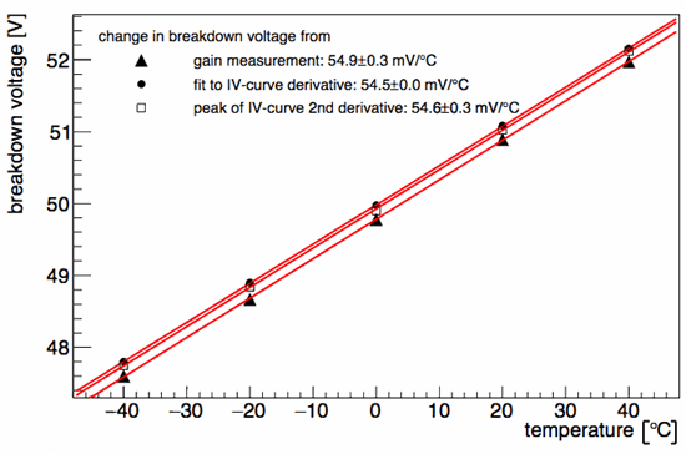
Figure 2. Dependence of breakdown voltage on temperature for Hamamatsu S13360-3050CS SiPM. The figure is from Otte et al. (2016).
Let β ≡ dVBD/dT and express VBD(T) = VBD,0[1 + β(T - T0)], where VBD,0 is the breakdown voltage at the reference temperature T0. The gain can now be written as:
Equation 4
To keep μ independent of T, ΔV(T) must be kept constant by adjusting VBIAS to offset the change in VBD. Namely:
Equation 5
A practical implementation of Equation 5 requires that β is known, that temperature can be accurately measured, and that a circuit with a temperature-voltage feedback loop can be constructed.
Practical implementation of gain control
Some manufacturers of SiPMs offer power supplies with built-in temperature compensation. Below is a view of a driver circuit (C12332-01) using a temperature-compensation power supply (C11204-01) by Hamamatsu.
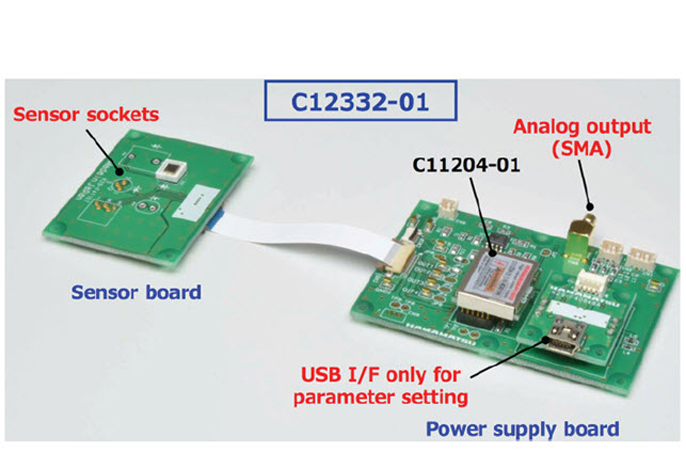
Figure 3. View of the Hamamatsu C12332-01 SiPM driver circuit with temperature compensation. The SiPM mounts in the sensor sockets of the sensor board.
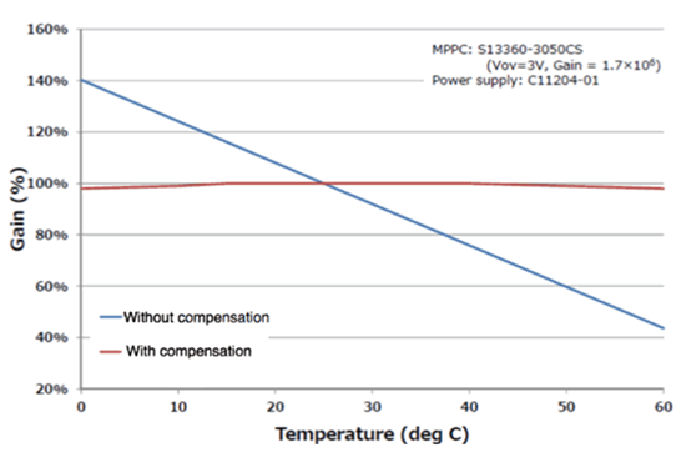
Figure 4. Gain variation versus temperature for Hamamatsu S13360-3050CS SiPM without temperature compensation (blue line) and with compensation (red line) provided by the C12332-01 driver circuit.
The SiPM is mounted on the "sensor board" containing the temperature sensor. Temperature information from the sensor goes to the "power supply board" where it is processed, and the feedback circuitry outputs the appropriate VBIAS to the SiPM. Figure 4 shows how the gain of Hamamatsu S13360-3050CS SiPM varies with temperature without temperature-compensation (blue line) and with temperature compensation (red line) provided by C12332-01.
The figure indicates that C12332-01 provides an excellent gain stabilization (gain variation less than about 2%) over at least a 60 °C temperature range.
Summary
For a fixed bias voltage, the gain of a SiPM changes linearly with temperature because the breakdown voltage varies linearly with temperature. Adjusting the bias voltage so that the overvoltage remains constant eliminates gain-temperature dependence. Manufacturers of SiPMs offer power supplies with a gain stabilization feature.
References
Otte, A. N., Garcia, D., Nguyen, T., Purushotham, D., Characterization of Three High Efficiency and Blue Sensitive Silicon Photomultipliers, Nuclear Inst. and Methods in Physics Research A, in press (2016)
- Confirmation
-
It looks like you're in the . If this is not your location, please select the correct region or country below.
You're headed to Hamamatsu Photonics website for US (English). If you want to view an other country's site, the optimized information will be provided by selecting options below.
In order to use this website comfortably, we use cookies. For cookie details please see our cookie policy.
- Cookie Policy
-
This website or its third-party tools use cookies, which are necessary to its functioning and required to achieve the purposes illustrated in this cookie policy. By closing the cookie warning banner, scrolling the page, clicking a link or continuing to browse otherwise, you agree to the use of cookies.
Hamamatsu uses cookies in order to enhance your experience on our website and ensure that our website functions.
You can visit this page at any time to learn more about cookies, get the most up to date information on how we use cookies and manage your cookie settings. We will not use cookies for any purpose other than the ones stated, but please note that we reserve the right to update our cookies.
1. What are cookies?
For modern websites to work according to visitor’s expectations, they need to collect certain basic information about visitors. To do this, a site will create small text files which are placed on visitor’s devices (computer or mobile) - these files are known as cookies when you access a website. Cookies are used in order to make websites function and work efficiently. Cookies are uniquely assigned to each visitor and can only be read by a web server in the domain that issued the cookie to the visitor. Cookies cannot be used to run programs or deliver viruses to a visitor’s device.
Cookies do various jobs which make the visitor’s experience of the internet much smoother and more interactive. For instance, cookies are used to remember the visitor’s preferences on sites they visit often, to remember language preference and to help navigate between pages more efficiently. Much, though not all, of the data collected is anonymous, though some of it is designed to detect browsing patterns and approximate geographical location to improve the visitor experience.
Certain type of cookies may require the data subject’s consent before storing them on the computer.
2. What are the different types of cookies?
This website uses two types of cookies:
- First party cookies. For our website, the first party cookies are controlled and maintained by Hamamatsu. No other parties have access to these cookies.
- Third party cookies. These cookies are implemented by organizations outside Hamamatsu. We do not have access to the data in these cookies, but we use these cookies to improve the overall website experience.
3. How do we use cookies?
This website uses cookies for following purposes:
- Certain cookies are necessary for our website to function. These are strictly necessary cookies and are required to enable website access, support navigation or provide relevant content. These cookies direct you to the correct region or country, and support security and ecommerce. Strictly necessary cookies also enforce your privacy preferences. Without these strictly necessary cookies, much of our website will not function.
- Analytics cookies are used to track website usage. This data enables us to improve our website usability, performance and website administration. In our analytics cookies, we do not store any personal identifying information.
- Functionality cookies. These are used to recognize you when you return to our website. This enables us to personalize our content for you, greet you by name and remember your preferences (for example, your choice of language or region).
- These cookies record your visit to our website, the pages you have visited and the links you have followed. We will use this information to make our website and the advertising displayed on it more relevant to your interests. We may also share this information with third parties for this purpose.
Cookies help us help you. Through the use of cookies, we learn what is important to our visitors and we develop and enhance website content and functionality to support your experience. Much of our website can be accessed if cookies are disabled, however certain website functions may not work. And, we believe your current and future visits will be enhanced if cookies are enabled.
4. Which cookies do we use?
There are two ways to manage cookie preferences.
- You can set your cookie preferences on your device or in your browser.
- You can set your cookie preferences at the website level.
If you don’t want to receive cookies, you can modify your browser so that it notifies you when cookies are sent to it or you can refuse cookies altogether. You can also delete cookies that have already been set.
If you wish to restrict or block web browser cookies which are set on your device then you can do this through your browser settings; the Help function within your browser should tell you how. Alternatively, you may wish to visit www.aboutcookies.org, which contains comprehensive information on how to do this on a wide variety of desktop browsers.
5. What are Internet tags and how do we use them with cookies?
Occasionally, we may use internet tags (also known as action tags, single-pixel GIFs, clear GIFs, invisible GIFs and 1-by-1 GIFs) at this site and may deploy these tags/cookies through a third-party advertising partner or a web analytical service partner which may be located and store the respective information (including your IP-address) in a foreign country. These tags/cookies are placed on both online advertisements that bring users to this site and on different pages of this site. We use this technology to measure the visitors' responses to our sites and the effectiveness of our advertising campaigns (including how many times a page is opened and which information is consulted) as well as to evaluate your use of this website. The third-party partner or the web analytical service partner may be able to collect data about visitors to our and other sites because of these internet tags/cookies, may compose reports regarding the website’s activity for us and may provide further services which are related to the use of the website and the internet. They may provide such information to other parties if there is a legal requirement that they do so, or if they hire the other parties to process information on their behalf.
If you would like more information about web tags and cookies associated with on-line advertising or to opt-out of third-party collection of this information, please visit the Network Advertising Initiative website http://www.networkadvertising.org.
6. Analytics and Advertisement Cookies
We use third-party cookies (such as Google Analytics) to track visitors on our website, to get reports about how visitors use the website and to inform, optimize and serve ads based on someone's past visits to our website.
You may opt-out of Google Analytics cookies by the websites provided by Google:
https://tools.google.com/dlpage/gaoptout?hl=en
As provided in this Privacy Policy (Article 5), you can learn more about opt-out cookies by the website provided by Network Advertising Initiative:
http://www.networkadvertising.org
We inform you that in such case you will not be able to wholly use all functions of our website.
Close


